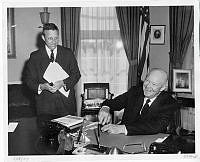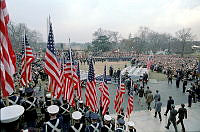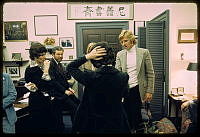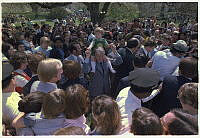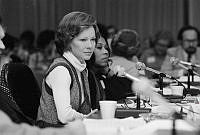A White House Exhibit on the National Parks
Copyright © October 01, 2010 White House Historical Association. All rights reserved under international copyright conventions. No part of this article may be reproduced or utilized in any form or by any means, electronic or mechanical, including photocopying, recording, or by any information storage and retrieval system, without permission in writing from the publisher. Requests for reprint permissions should be addressed to books@whha.org
Since the Kennedy administration, White House Christmas decorations have been designed each year to coincide with a specific theme. Many themes are based on traditional holiday subjects, while others are associated with projects favored by the first ladies. For Christmas 2007, First Lady Laura Bush chose to showcase our nation’s scenic wonders and historic treasures with “Holiday in the National Parks.” It was viewed as a kick-off event for the National Park Service centennial celebration in 2016 and was a subject in which Mrs. Bush was especially interested. As first lady, she had participated in more than forty-five events in support of the national parks and had visited more than thirty-one parks and historic sites throughout the United States. She served as the honorary chair of the National Park Foundation and actively promoted programs such as First Bloom and Junior Rangers to introduce young people to the parks. Privately, she had experienced several sites more extensively during annual hiking trips with a group of childhood friends.1
The 2007 decorations, representing the various parks, memorials, seashores, historic sites, and monuments under the care of the National Park Service were displayed in the public rooms of the White House. Guests and visitors saw a large model of the Cape Hatteras lighthouse when they entered the East Wing and found a small bronze copy of the Statue of Liberty in the Entrance Hall on the State Floor. Models of such places as Federal Hall in New York City, Frederick Douglass House in Washington, D.C., San Antonio Missions, and South Dakota’s Mount Rushmore sat on tabletops in the Ground Floor Corridor. Two oil paintings, a scene of the Grand Canyon and another of Zion National Park, were executed by Pennsylvania artist Adrian Martinez and set into the large curved niches of the Cross Hall. Ornaments on the main Christmas tree in the Blue Room included 347 gold balls, each with a park scene painted by an artist chosen by the site. In the State Dining Room, even the gingerbread house, a depiction of the White House, was surrounded by marzipan copies of wildlife found in many parks—bears, coyotes, moose, elk, and raccoons—in addition to the Bush family pets.
For the East Colonnade, the long passageway beginning the tour route, Mrs. Bush proposed a photographic display to show various presidents and first ladies in the national parks. The White House Photo Office along with the National Archives, two presidential home sites, and ten presidential libraries perused their photograph files. Numerous images were found of presidents and family members touring monuments and viewing breathtaking scenery. Some excursions were official, often coinciding with important celebrations, while others were family vacations. In total, twenty-four photographs were chosen for the exhibit. The earliest dated to 1880 and featured President and Mrs. Rutherford B. Hayes in Yosemite Valley. The most recent images were from 2007 and documented a visit by President and Mrs. George W. Bush to Jamestown National Historic Site during its 400th anniversary celebration and the first lady’s trip to Grand Teton National Park.

In the Blue Room, the Christmas tree was hung with ornaments hand-painted with scenes of national parks. The White House ornament was painted by artist Margaret Huddy.

“Holiday in the National Parks” was the theme of the Christmas 2007 White House decorations. An exhibit of photographs of presidential visits to National Parks was hung in the East Wing and it is with the author’s thanks and appreciation to the varioius institutions that supplied them that a selection of photographs considered for the exhibit is illustrated on the pages that follow.














